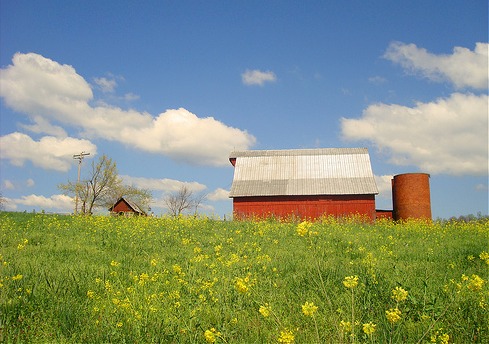 The outlook for small farms could be getting a bit sunnier.Photo: andyrobeI write on Grist about my small farm, but my day job is different. I’m an organizer for the Nebraska-based Center for Rural Affairs (CFRA). One of the things we do at CFRA is try to tweak federal farm policies in ways that help rural farm communities thrive. And this past week, I’ve been thinking a lot about developments in Washington that affect both new farmers and rural communities in general.
The outlook for small farms could be getting a bit sunnier.Photo: andyrobeI write on Grist about my small farm, but my day job is different. I’m an organizer for the Nebraska-based Center for Rural Affairs (CFRA). One of the things we do at CFRA is try to tweak federal farm policies in ways that help rural farm communities thrive. And this past week, I’ve been thinking a lot about developments in Washington that affect both new farmers and rural communities in general.
Recently, White House phone lines have been ringing off the hook as thousands of consumers responded to a coordinated action alert by farm groups, calling to express their support for the Fair Livestock Competition rule. Also known as the “proposed GIPSA rule” [PDF], the goal is to create active competition in the livestock marketplace, so that meat processors can’t unfairly manipulate prices. The USDA has written a fairly strong rule, and industry pressure has caused delays in the roll out of the new rule.
Meanwhile, President Obama released his budget this week, which included farm payment cuts to wealthy farmers and land owners, saving an estimated $2.5 billion dollars over 10 years. The idea to bar people over a certain income from receiving any farm payments caught hold in the last farm bill debate. This new proposal would cut off farm payments to individuals making more than $500,000 instead of $750,000 in on-farm income, and limit off-farm income to $250,000 instead of $500,000.
Let’s examine the Fair Livestock Competition rule first. In the not-so-distant past, meatpackers and processors had to compete with each other to buy livestock. Sale barns dotted the countryside, and a farmer or rancher could often call a handful of nearby processors to see who would give him the best price on that day. Beginning farmers and ranchers could make a decent living with livestock when markets were competitive. Now, because of the consolidation of the meatpacking industry, most independent farmers have only once place they can sell, and the meatpackers control the price they pay.
The new Fair Livestock Competition rule requires meatpackers to treat independent family farmers and ranchers fairly, and disallows the practice of paying the largest livestock producers more just because they’re big. That makes it easier for small-scale farms to make a living raising livestock, because you’ll get the same price whether you have 100 or 100,000 animals. This provision is critical to new operations, which don’t have the capital — or sometimes, the desire — to start with thousands of animals. Having a fair price on the open market is even better for me, someone who only has a few sheep and sells directly to customers. If meat in the grocery store is priced fairly, it’s good for all livestock producers.
Obama’s proposal to restrict wealthy farmers from subsidies will also positively impact new growers. On the surface, this might seem puzzling — how would small farmers and ranchers with income levels far below the cutoff be affected? Many beginning farmers and ranchers don’t grow crops that get subsidized, and they don’t own enough land to make much money off of “direct payments” that pay landowners for owning land.
But these payments make growing grain and owning land more profitable, so people with lots of money see farm land as a good investment. These investors often have money to spend and can take a short-term loss — so when farm land comes up for sale, they buy it even if it’s overpriced. This drives up the price of the next piece of land that comes up for sale, to the point where it is unaffordable for anyone getting started.
Unfortunately, cutting off very wealthy people from farm payments isn’t as effective as it could be. The law relies on “adjusted gross income,” or income after taxes and business deductions. A good accountant can help reduce a person’s adjusted gross income. This way of determining whether an individual receives a payment actually encourages wealthy landowners to buy up more land or make other unnecessary investments in their business so they can still qualify for government payments.
A better, more effective way to cap farm payments has been championed for years by Sen. Chuck Grassley (R-Iowa), cosponsored in the past by former Sens. Byron Dorgan (D-N.D.) and Russ Feingold (D-Wis.). Grassley’s proposal would put a hard cap on payments to an individual, with the maximum farm payment being $250,000. This makes land speculation much less profitable. Unfortunately, the idea has failed to get through the Senate, even with 56 votes in favor, when it comes up for a vote.
So if you know a small family farmer or rancher — or prefer their products to the industrially produced stuff — pay attention to the policies that affect them, and act when you can.




